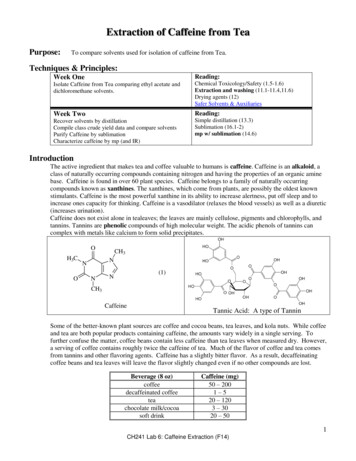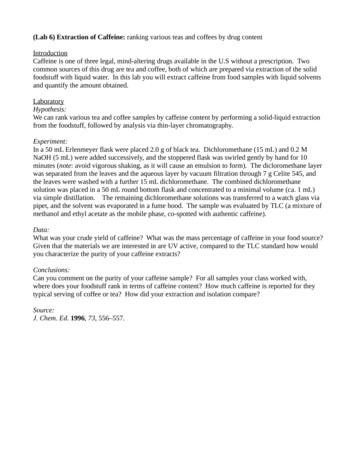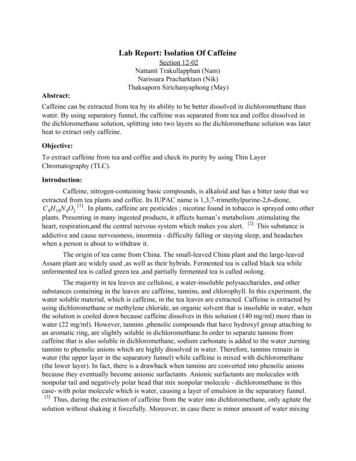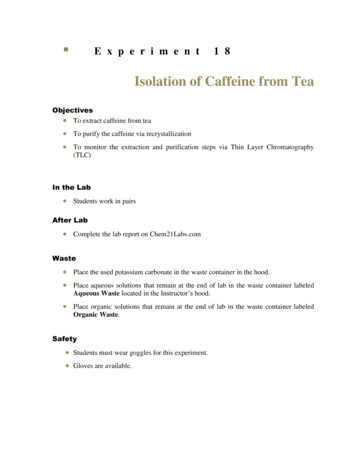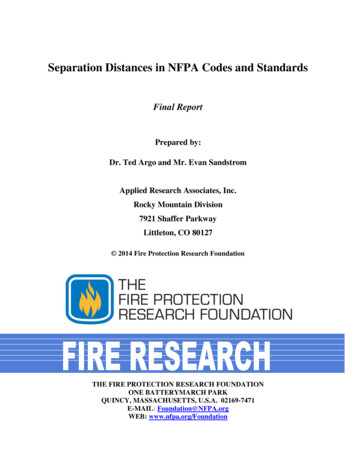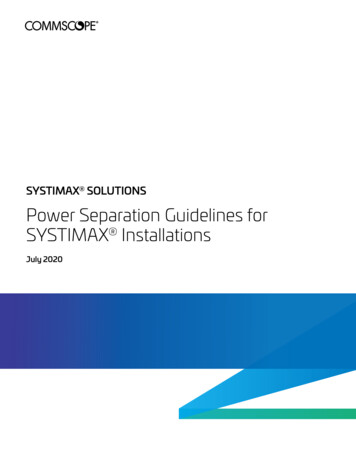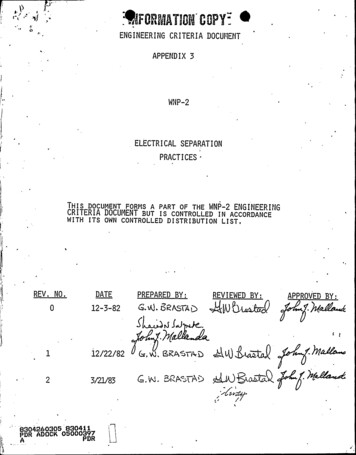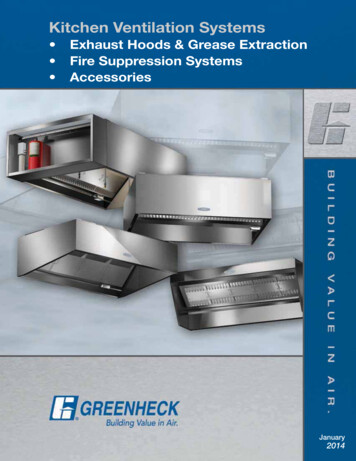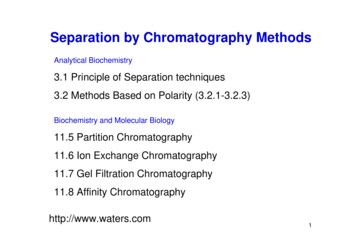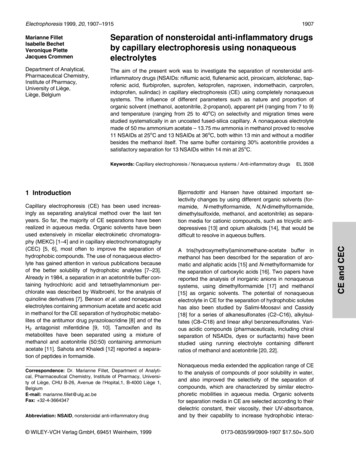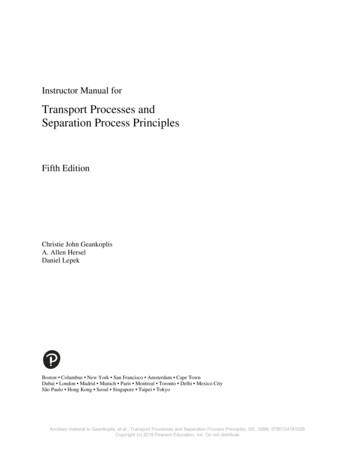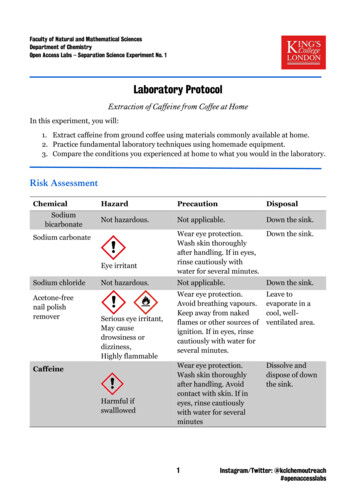
Transcription
Faculty of Natural and Mathematical SciencesDepartment of ChemistryOpen Access Labs – Separation Science Experiment No. 1Laboratory ProtocolExtraction of Caffeine from Coffee at HomeIn this experiment, you will:1. Extract caffeine from ground coffee using materials commonly available at home.2. Practice fundamental laboratory techniques using homemade equipment.3. Compare the conditions you experienced at home to what you would in the laboratory.Risk nDisposalNot hazardous.Not applicable.Down the sink.Sodium carbonateEye irritantSodium chlorideAcetone-freenail polishremoverNot hazardous.Serious eye irritant,May causedrowsiness ordizziness,Highly flammableCaffeineHarmful ifswalllowedWear eye protection.Down the sink.Wash skin thoroughlyafter handling. If in eyes,rinse cautiously withwater for several minutes.Not applicable.Down the sink.Wear eye protection.Avoid breathing vapours.Keep away from nakedflames or other sources ofignition. If in eyes, rinsecautiously with water forseveral minutes.Leave toevaporate in acool, wellventilated area.Wear eye protection.Wash skin thoroughlyafter handling. Avoidcontact with skin. If ineyes, rinse cautiouslywith water for severalminutesDissolve anddispose of downthe sink.1Instagram/Twitter: @kclchemoutreach#openaccesslabs
Figure 1. Materials needed:SodiumbicarbonateWaterSaltAcetone-freenail polish removerGroundcoffeeFigure 2. Equipment needed:Teaspoon, Tablespoon, ForkCoffee machinefilter paperScissorsTall glassTwo small glassesOven dishRubber bandOven and a hobNeedle(CAUTION!)Sticky tackEmpty plastic bottlewith a narrow neckCooking pot with a lidKitchen scales(optional)Materials are given as a suggestion. However, if these are not something you can access, westrongly encourage you to use any materials you have available that you think would work ina similar way!We would love to know what materials you end up using and how you think theyaffected your experiment! Share this with us on Instagram or Twitter using thehandle @kclchemoutreach and the #openaccesslabs. Alternatively, you can letus know by sending us an email to chemistry-outreach@kcl.ac.uk!2Instagram/Twitter: @kclchemoutreach#openaccesslabs
Open Access LabsOpen access labs are part of the King’s College London annual outreach programme whichaims to make science, in particular chemistry, available to students who are interested inpursuing a career in STEM. In the last three years, several events have been organised and 400 prospective scientists were able to experience a real chemistry lab. They made aspirin,investigated the chemistry of water, changed states of matter, or used analytical methodssuch as infrared spectroscopy, thin-layer chromatography and proton NMR spectroscopy,that are normally only covered in their textbooks.The Open Access Labs programme is supported by RSC and is available for pupils from nonselective schools. At King’s, we want to welcome a diverse range of students into our inclusivedepartment. We have gender parity at undergraduate (UG) level with more than 70% of ourstudents identifying as BAME. We want to establish close collaborations with local schoolsand form lasting relationships with students to support them on their academic journeys.In response to COVID-19 making our UG teachinginaccessible, we have created online content thatwill enable you to perform an Open Access Lab dayremotely. This resource has been developed by DrFilip Sebest in collaboration with Dr Helen Coulshedand Dr Grace Walden.We hope you enjoy it as much as we have enjoyedcreating it!Dr Filip SebestChemistry TeachingTechnicianDr Helen CoulshedLecturer in ChemicalEducation1. Learning OutcomesBy the end of this practical, you should be able to:1.2.3.4.Give examples of liquid-liquid and solid-liquid separation techniques.Recognise the importance of understanding the chemistry of each step in a procedure.Perform simple chemical calculations.Realise that chemistry is all around us!Transferable skills you will practice during this experiment: Manual dexterityCritical thinkingNumeracy skillsSafe working Time managementDecision makingObservation skillsFollowing instructionsBefore you start you can watch our instructional video which demonstrates the keytechniques that you will be using during the experiment.media.kcl.ac.uk/media/1 2kd6r2zn3Instagram/Twitter: @kclchemoutreach#openaccesslabs
2. IntroductionCaffeine is a bitter, white crystalline alkaloid present in around 60 plantspecies, most commonly coffee beans (Figure 3), tea leaves and kola nuts.In plants, it acts as a natural pesticide because it can paralyse or even killinsects feeding on the plant.Caffeine is the world’s most widely consumed psychoactive drug;Figure 3. Coffee plant.however, it is legal and unregulated in nearly all parts of the world. Itstimulates the central nervous system reducing fatigue and drowsiness.It improves reaction time, wakefulness, concentration, and motor coordination. It can alsoimprove athletic performance, muscular strength, and power. Medically, caffeine is used totreat certain types of lung diseases as well as postural hypotension (having low blood pressurewhen you stand up from sitting or lying down). However, overconsumption of caffeine canlead to a mild form of drug dependence associated with withdrawal symptoms such asheadache, sleepiness, or irritability. The maximum recommended daily intake of caffeinedepends on the age of an individual (Table 1). For adults, up to 400 mg a day is consideredsafe while a lethal dose would equal to approximately 10 g a day. For reference, one cup ofcoffee contains 80–175 mg of caffeine while one cup of black tea contains 47–90 mg.Interestingly, one cup of decaffeinated coffee or tea can still contain up to 10 mg of caffeine!Table 1. Maximum recommended daily intake of caffeine based on age.Age of an individual4–6 years7–9 years10–12 years13–18 yearsAdultsMaximum recommended daily intake of caffeine45 mg62.5 mg85 mg2.5 mg/kg of body weight but no more than 100 mg400 mg3. Background TheoryCaffeine was first isolated from coffee in 1819 by a German chemist, Friedlieb FerdinandRunge. In its pure form, it is an odourless white solid with a melting point of 235–238 C.Caffeine is classified as a heterocycle (Figure 4): a cyclic compound that has two or moredifferent elements in its ring(s) (in this case nitrogen and carbon).Caffeine is weakly basic and its solubility in water at roomtemperature is quite low (2 g/100 mL) but increases dramatically inboiling water (66 g/100 mL)! Nowadays, it is usually extracted fromcoffee filtrate using ethyl acetate; this organic solvent (an ester)presents considerably lower health and environmental hazards thanthe chlorinated and aromatic organic solvents used formerly. Besidescaffeine, coffee also contains other chemicals such as tannins. ToFigure4.Chemicalseparate them from caffeine, and to increase the purity of thestructureofcaffeine.caffeine product, tannins are converted into their sodium saltderivatives by the action of an inorganic base. Since tannins arepolyphenols, a common choice of an inorganic base is either sodium carbonate or sodiumhydroxide as these are strong enough to deprotonate phenolic hydroxyl groups. Whentannins become ionic, they remain dissolved in water while caffeine gets extracted by theorganic solvent during the water-ethyl acetate liquid-liquid extraction.4Instagram/Twitter: @kclchemoutreach#openaccesslabs
4. ProcedureStage 1: preparationa) Preheat your oven to 100 C.b) Weigh out 5 g of sodium bicarbonate ( 1 heaped teaspoon), spread it evenly onto aglass oven dish or an oven tray, then heat it at 100 C in the oven for 1 hour (Figure 5).Take it out and let it cool down completely.100 C, 1 hFigure 5. Conversion of sodium bicarbonate to sodium carbonate.c) Weigh out 30 g of ground coffee ( 6 levelled tablespoons) and place it into a cookingpot. Add 150 mL of cold water and stir thoroughly with a tablespoon. Cover with a lid.d) Create a home-made separating funnel from a plastic bottle with tall narrow neck:More information can be found in Figure 6 and at media.kcl.ac.uk/media/1 2kd6r2znCAUTION: involves a needle and open flame. Carefully pierce a small hole into thecentre of the bottle lid as well as the bottom of the bottle using a needle – it helps topre-heat the needle on a hob for 5 seconds and to pierce the hole within the next 5seconds while it is still hot (keep the bottle nearby). Make sure you only hold theneedle at the very end, so you do not burn your fingers, and do not forget to switch offthe hob after use. Double check that the plastic was pierced through and seal bothholes tightly with a piece of white tack or another type of a sticky adhesive.Reheat the needleSealFigure 6. Preparation of a home-made separating funnel.5Instagram/Twitter: @kclchemoutreach#openaccesslabs
* If you prefer not to use a naked flame, or if you don’t have a gas hob, you can try toheat the tip of the needle to a sufficiently high temperature by submerging it in boilingwater (this may or may not work depending on the thickness of the plastic bottle).Alternatively, you can use a push cap bottle such as a travel bottle and avoid piercing ahole altogether. The larger the hole the harder the extraction will be.e) Prepare a saturated solution of salt ( 3 levelled teaspoons; 17 g) in water (50 mL)and pour approximately half of it into the separating funnel you have just created(double check the bottom hole of the bottle is tightly sealed). If it is leaking, make surethe hole is sealed more tightly. Save the second half of this solution for later.Note: It is difficult to prepare saturated solutions exactly, especially at home. If youcannot dissolve all the solid even after 2 min of stirring with a spoon, add a teaspoon ofwater and stir again. Repeat this process until you dissolve all the solid (Figure 7).Figure 7. Preparing a saturated solution of salt in water.f) Add the whole volume of nail polish remover (200 mL) into the bottleand close it with a sealed lid. You should see two layers (Figure 8).g) Holding the bottle with both hands and pressing on the adhesives,shake it for 5 s. Carefully open the lid to vent off the pressure whichhas built up, then close the lid. Repeat twice more, then shake foranother 30 s, vent the pressure, and leave it to stand for 2 minduring which two layers will form. Carefully invert the bottle and holdit above a small empty glass (Figure 9).Figure 8.Two layersin the bottle.Figure 9. Liquid-liquid extraction.Remove both sticky adhesives, starting with the top one. You may need to use a needleto clear the hole if pieces of the sticky adhesive got pushed into it. Once the holes arefree, liquid will start to trickle/flow from the bottle into the glass. If, at any point, the6Instagram/Twitter: @kclchemoutreach#openaccesslabs
flow slows down significantly or stops, gently squeeze the bottle to let some more airin. If this does not work, try squeezing slightly harder.Let the bottom layer flow into the glass, making sure you cover the top hole as theseparation line approaches the bottle lid. Then, as soon as the top layer starts to drip(you may notice a slightly faster rate of dripping), double check the top hole is sealedand invert the bottle. Pour the contents into an empty clean cup (Figure 10).Figure 10. Liquid-liquid separation.h) Pour the clear liquid from the cup back to the empty nailpolish remover bottle, making sure no water droplets (ifpresent) go through (Figure 11). Close the nail polish remover bottle andwash the “separating funnel” with water: you will need it later.Stage 2: extractionFigure 11. Pureorganic layer.a) Add all the sodium carbonate to the pot containing your coffeemixture, stir with a spoon until it is dissolved, and gently bring to a boil. Lower theheat and simmer for 30 mins, covered by a lid. Then let it cooldown to room temperature.Note: Make sure the water does not evaporate or else you will burnyour coffee mixture!b) In the meantime, set up your gravity filtration. Using a tallcup/glass and one piece of coffee machine filter paper, bend theedges of the filter paper and secure them to the cup with a rubberFigure 12. Gravityband to create a pouch (Figure 12). Aim for the filter paper tofiltration setuptouch at least one side of the glass to speed up the filtration.c) Once the coffee mixture has cooled down, transfer the contents of the pot into the filterpaper pouch. Be careful not to tear the paper as that would allow ground coffee to passthrough. If the coffee water does not all fit in one go, wait for enough liquid to passthrough the paper until there is enough space for the rest of the coffee water. Allow tostand until you can see ground coffee in the filter paper and there is not a layer ofwater above it (Figure 13, picture #3), or if it is taking longer than 1 hour. At this7Instagram/Twitter: @kclchemoutreach#openaccesslabs
point, carefully remove the rubber band, fold the filter paper to contain the groundcoffee in the pouch and – into a separate cup – gently squeeze the residual coffee waterthrough the paper. This will maximise the amount of caffeine we can extract but it islikely to force some of the ground coffee through as well.Figure 13. Performing gravity filtration.d) Perform gravity filtration with the residual coffee water into a new glass. If it is takinglonger than 30 mins, gently press on the side of the filter paper pouch to speed up theprocess, however, make sure no ground coffee passes through this time. Combine thetwo filtrates to obtain the final filtrate (Figure 14).Figure 14. Gravity filtration of residual coffee water.e) Into your washed and sealed “separating funnel”, slowly add the coffee filtrate (makingsure that no ground coffee, if present, gets into the separating funnel), then add yourorganic solvent. Close the bottle and shake for 2 mins, ensuring that the pressurebuild-up is regularly vented
Extraction of Caffeine from Coffee at Home In this experiment, you will: 1. Extract caffeine from ground coffee using materials commonly available at home. 2. Practice fundamental laboratory techniques using homemade equipment. 3. Compare the conditions you experienced at home to what you would in the laboratory. Risk Assessment
